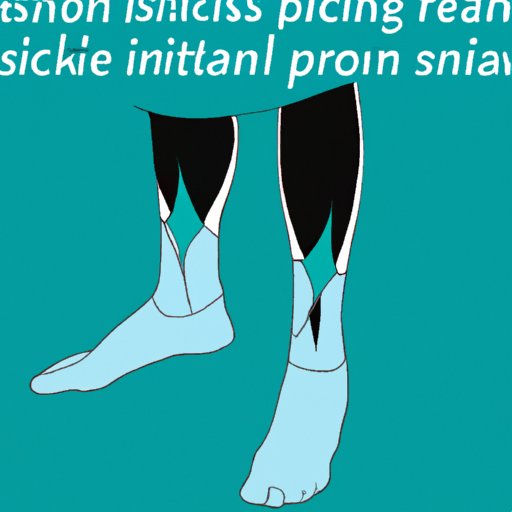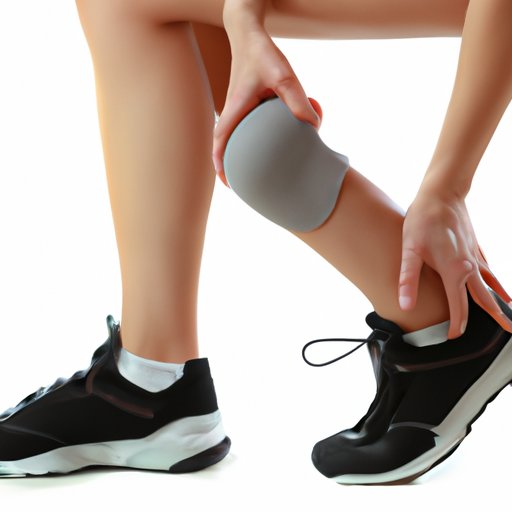I. Introduction
If you have ever experienced a sharp pain in the front of your leg after exercise, you may have been dealing with shin splints. Shin splints, also known as medial tibial stress syndrome, is a common injury among athletes and fitness enthusiasts. Understanding the causes, symptoms, and treatment options for this condition is important to reduce pain and prevent future occurrences.
II. Understanding Shin Splints: Identifying Causes, Symptoms and Treatment Options
Shin splints are typically caused by repetitive stress on the shin bone and associated muscles. Some of the common causes include:
1. Overuse and repetitive stress
Overuse of the shin muscles through activities such as running, jumping, and dancing can cause excessive stress on the shin bone and muscles. This can result in inflammation and pain.
2. Improper footwear
Wearing shoes that lack appropriate support or are worn out can exacerbate the pressure on the shins and lead to shin splints.
3. Weakness in muscles surrounding the shin
Weakness in the muscles surrounding the shin bone can cause the muscles to overwork and create more pressure on the shin bone.
Shin splint symptoms typically include sharp pain and tenderness on the front of the leg, especially during exercise. Treatment options for shin splints include:
1. Rest and Ice
Resting the shins and applying ice for 15-20 minutes every few hours can help reduce inflammation and pain.
2. Over-the-counter pain relief medication
Nonsteroidal anti-inflammatory medications (NSAIDs) such as Ibuprofen can help reduce pain and inflammation.
3. Compression and elevation
Compression sleeves can help reduce swelling, and keeping the legs elevated can reduce pressure on the shins and promote blood flow.
III. Rest and Recovery: Simple Steps to Help Treat Shin Splints
One of the most important steps for treating shin splints is rest and recovery. Taking time off from high-impact activities and allowing the shins to heal is important to prevent further injury. A recommended recovery period is about two to four weeks, but every individual’s experience may vary.
There are several techniques for promoting rest and recovery:
1. Physical therapy
A physical therapist can help develop a plan for rest and recovery and guide you through exercises that will help restore strength to the affected area.
2. Massage
Massaging the muscles surrounding the shin bone can help reduce tension and promote blood flow, which can speed up the recovery process.
3. Taking a break from high-impact activities
High-impact activities such as running, jumping, and dancing can worsen shin splint symptoms. It is recommended to engage in low-impact activities such as cycling and swimming during the recovery period.
IV. The Benefits of Stretching: How to Use Stretching Techniques to Alleviate Shin Splints
Stretching is a crucial component of the recovery process for shin splints. Stretching can help improve flexibility and reduce tension in the muscles surrounding the shin bones.
1. Calf stretches
Stretching the calf muscles can help reduce stress on the shin bone. Stand near a wall with one foot in front of the other, and press the heel of the back foot down while keeping the leg straight.
2. Foot flexor stretches
Sitting on the floor with your legs extended in front of you, loop a towel or resistance band around the balls of your feet and gently pull the tops of your feet towards you to stretch the muscles in the front of your shin.
3. Toe curls
Sit on a chair with your feet flat on the ground. Place a towel on the floor and scrunch it up using only your toes, then release and repeat several times.
It is recommended to stretch for about 10-15 minutes before and after exercise, keeping stretches static, avoiding bouncing, as this will increase your risk of injury.
V. Strengthen and Protect: Simple Exercises for Preventing and Treating Shin Splints
In addition to stretching, strengthening exercises can help prevent and treat shin splints.
1. Toe walks
Walk on your toes for about 20-30 yards, repeating several times. This will help strengthen the muscles in your shins.
2. Heel walks
Walk on your heels for about 20-30 yards, repeating several times. This exercise helps strengthen the muscles in your calves.
3. Ankle circles
Sit on a chair with your legs extended in front of you. Slowly rotate your feet in a circular motion, repeating several times. This exercise helps improve ankle mobility.
It is recommended to practice strengthening exercises about three to four times a week.
VI. Footwear Considerations: The Importance of Proper Shoes in Shin Splint Treatment
Proper footwear is important in preventing and treating shin splints.
1. Shock absorption
A shoe with good shock absorption can help reduce impact on the shin bones. Look for shoes with cushioning in the heel and midsole.
2. Arch support
Shoes with proper arch support can help distribute weight evenly and reduce pressure on the shins.
3. Flexibility
A shoe with appropriate flexibility can help reduce stress on the shin bones. Look for shoes that bend at the ball of the foot and not in the middle.
When selecting shoes, it is important to choose ones that are appropriate for your activity type and foot shape. A specialist can help you find the right shoes that meet your needs.
VII. When to See a Doctor: Warning Signs and When to Seek Professional Treatment
While most cases of shin splints can be treated at home, there are some warning signs that you may need to seek professional treatment.
1. Importance of seeking professional help
If your pain is severe and not improving with home treatment, or if you have been experiencing shin pain for more than a month, it may be time to seek professional help.
2. Warning signs
If you notice lumps, bumps, or sore spots on your legs, or if you have pain or swelling in areas other than your shins, you should seek medical attention.
3. Medical treatment options
Medical treatment options for shin splints include:
– Physical therapy to develop a customized recovery and exercise plan
– Orthotics (shoe inserts) to provide extra support and reduce pressure on the shins
– Surgery may be recommended in severe cases if other treatments do not work

VIII. Risk Reduction and Prevention: Tips and Tricks for Avoiding Shin Splints in the Future
In addition to treatment, taking steps to prevent shin splints in the future is important in maintaining healthy, pain-free legs.
1. Progressive training
Gradually increasing the duration and intensity of your workouts can help prevent excessive stress on your shins. A good rule of thumb is to increase training efforts by no more than ten percent per week.
2. Good footwear
As mentioned previously, proper footwear is essential in preventing shin splints. Make sure you are wearing appropriate shoes for your foot type and activity.
3. Proper form
Ensuring proper form during exercise can help prevent overuse injuries such as shin splints. Seek guidance from a trainer or physical therapist to perfect your form.
Additional prevention techniques include regular stretching and strengthening exercises, maintaining a healthy diet and weight, and getting adequate rest and recovery time between workouts.
IX. Conclusion
Shin splints can be a frustrating and painful injury, but with proper understanding of the causes, symptoms, and treatment options, relief is possible. Rest and recovery, stretching, strengthening, wearing proper footwear, and taking preventative measures can all aid in reducing the risk and pain associated with shin splints. Empathizing with those dealing with shin splints, we hope that this guide provides helpful information and encourages best practices for reducing pain and preventing future occurrences.
